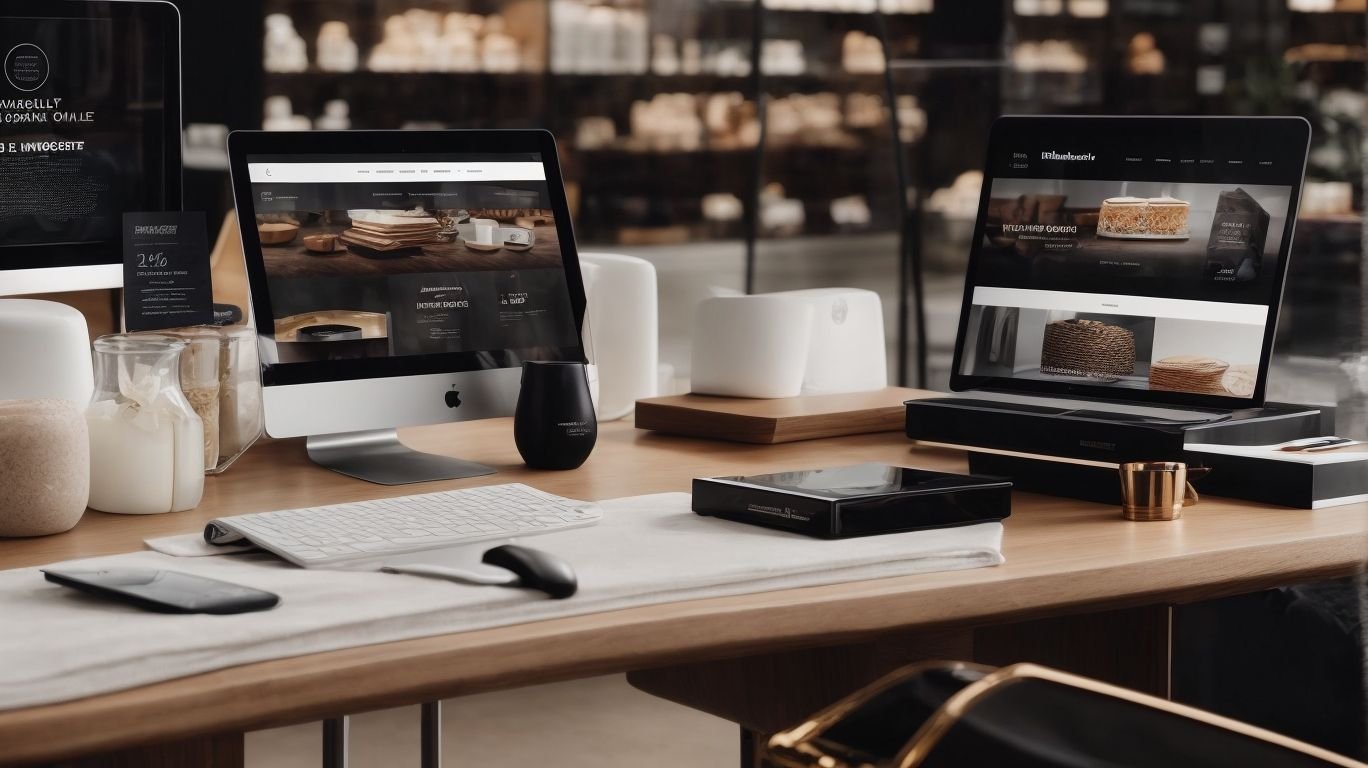E-commerce website design refers to the process of creating an online platform for buying and selling products or services. It involves a combination of visual aesthetics, user interface, and functionality to create an attractive and user-friendly online store. In today’s digital age, having an effective e-commerce website design is crucial for the success of any business.
A study conducted by the Baymard Institute found that 69.23% of online shopping carts are abandoned due to issues with the website design. This highlights the importance of designing a user-friendly and efficient e-commerce website.
The key elements of e-commerce website design include:
- User-friendly navigation to help customers easily find what they are looking for.
- Responsive design that allows the website to adjust to different screen sizes and devices.
- High-quality product images to showcase the products accurately.
- Clear and concise product descriptions to inform customers about the product.
- An easy and hassle-free checkout process to minimize cart abandonment.
- Secure payment options to build trust with customers.
There are various types of e-commerce website design, including:
- Single-page design, where all the content is on one page, making it easy for customers to navigate.
- Multi-page design, which involves multiple pages for different categories and products.
- Grid layout design, where products are displayed in a grid-like format, making it easy to browse.
- Minimalist design, which focuses on simplicity and minimal use of elements to create a clean and modern look.
- Flat design, which uses flat illustrations and minimalistic elements to create a simple and user-friendly design.
To ensure an effective and successful e-commerce website design, some best practices to follow include:
- Keeping the design simple and easy to navigate for a better user experience.
- Using high-quality visuals to showcase products and engage customers.
- Utilizing white space to make the design less cluttered and more visually appealing.
- Optimizing the website for mobile devices as more people are shopping on their phones.
- Maintaining a consistent branding and design theme throughout the website.
- Making it easy for customers to contact customer support for any queries or concerns.
Common mistakes to avoid in e-commerce website design include:
- Poor navigation and user experience, which can frustrate customers and lead to cart abandonment.
- Slow loading speed, which can drive customers away and affect search engine ranking.
- Lack of mobile optimization, which can hinder the shopping experience for customers.
- A complicated checkout process, which can cause customers to abandon their cart.
- Inconsistent branding and design, which can confuse customers and affect the overall brand image.
By understanding the importance, key elements, types, best practices, and mistakes to avoid in e-commerce website design, businesses can create a successful and efficient online platform for their customers.
Key Takeaways:
What Is E-commerce Website Design?

Photo Credits: Kinemastermodpro.Xyz by Jack Jackson
What Is E-commerce Website Design? E-commerce website design is the process of creating and designing websites specifically for online businesses. This involves developing user-friendly interfaces, incorporating secure payment gateways, and optimizing for mobile devices.
The key focus of good e-commerce website design is to provide a seamless and enjoyable shopping experience for customers, ultimately leading to increased sales and customer satisfaction.
An interesting fact: Did you know that 88% of online shoppers are less likely to return to a site after a bad experience? Therefore, it is essential to invest in high-quality e-commerce website design for the success of an online business.
Why Is E-commerce Website Design Important?

Photo Credits: Kinemastermodpro.Xyz by Gabriel Nelson
Having a successful e-commerce website design is crucial for the prosperity of your online business. A well-crafted website can have a significant impact on customer experience, conversion rates, and overall profitability. It creates a positive first impression, instills trust, and enhances brand credibility.
A user-friendly interface, intuitive navigation, and responsive design are essential elements that improve customer satisfaction and encourage them to spend more time on your site. Furthermore, a well-designed e-commerce website can also improve search engine rankings and drive more organic traffic.
Investing in professional website design is a crucial step in attracting and retaining customers in the competitive online marketplace.
What Are The Key Elements Of E-commerce Website Design?

Photo Credits: Kinemastermodpro.Xyz by Bruce Taylor
When it comes to creating an effective e-commerce website, there are certain key elements that are crucial for success. In this section, we will discuss the essential components of e-commerce website design that can make or break the user experience. From user-friendly navigation to secure payment options, each element plays a vital role in creating a seamless and satisfying shopping experience for customers. So, let’s dive in and explore the key elements of e-commerce website design.
1. User-Friendly Navigation
User-friendly navigation is vital for an efficient e-commerce website design. It improves the user experience, increases engagement, and boosts conversions. To achieve user-friendly navigation:
- Create a clear and intuitive menu structure, organizing products into logical categories.
- Include a search bar with auto-suggestions to help users quickly find what they’re looking for.
- Implement breadcrumb navigation, allowing users to easily navigate back to previous pages.
- Use descriptive and visually appealing buttons and icons for easy navigation.
- Optimize for mobile devices, ensuring menus are easily accessible and responsive.
By following these steps, you can create a seamless navigation experience that keeps users engaged and encourages them to explore and make purchases on your e-commerce website.
2. Responsive Design
Responsive design is a crucial element of successful e-commerce website design. It ensures that the website adapts and functions properly across different devices and screen sizes, providing an optimal user experience. To implement responsive design effectively, consider the following steps:
- Use a mobile-first approach, designing for small screens first and then scaling up.
- Utilize fluid layouts, allowing the content to adjust proportionally to the screen size.
- Optimize images and media for different resolutions to ensure fast loading times.
- Implement responsive typography, adjusting font sizes and line spacing for readability on different devices.
- Test the website on various devices and browsers to ensure a seamless user experience.
3. High-Quality Product Images
To improve the visual appeal and boost sales, it is crucial to have high-quality product images in e-commerce website design. Here are some steps to ensure the use of top-notch product images:
- Invest in professional photography or use clear, high-resolution images from reliable sources.
- Ensure proper lighting and angles to accurately showcase the product.
- Use multiple images to display different perspectives and details.
- Optimize image file sizes to maintain website loading speed.
- Implement zoom and enlarge features for customers to closely examine products.
Incorporating these steps will help create a visually enticing shopping experience, resulting in increased customer trust and conversion rates.
4. Clear and Concise Product Descriptions
Effective e-commerce website design relies on clear and concise product descriptions. These descriptions provide customers with essential information about the product, aiding them in making informed purchasing decisions. Here are some steps to create clear and concise product descriptions:
- Highlight key features: Identify and emphasize the most important features of the product.
- Use bullet points: Break down information into easy-to-read bullet points for quick comprehension.
- Be specific: Clearly describe product specifications, dimensions, materials, and any other pertinent details.
- Focus on benefits: Highlight how the product solves a problem or meets a need for the customer.
- Keep it concise: Use clear and concise language without unnecessary fluff or jargon.
An online clothing retailer saw an increase in sales and customer satisfaction after revamping their product descriptions to be clear and concise. By providing detailed information and highlighting the benefits of each item, customers felt more confident in their purchases.
5. Easy Checkout Process
An easy checkout process is crucial for a seamless e-commerce experience. Here are some steps to ensure a smooth checkout process:
- Streamline the process: Keep the number of steps to a minimum, reducing form fields and unnecessary information.
- Guest checkout option: Offer a guest checkout option to avoid forcing customers to create an account.
- Clear progress indicators: Show customers how far they are in the Easy Checkout Process to avoid confusion or frustration.
- Multiple payment options: Provide a variety of secure payment options to cater to different customer preferences.
- Mobile optimization: Ensure that the checkout process is mobile-friendly, with responsive design and easy navigation.
- Error handling: Clearly communicate any errors or issues during the checkout process and provide helpful guidance for resolution.
6. Secure Payment Options
Secure payment options are essential for e-commerce websites to establish trust and safeguard customer information. Here are some steps to ensure secure payment options:
For more information on e-commerce website design, visit this reputable source.
- Implement SSL encryption to safeguard sensitive data during transactions.
- Utilize reputable payment gateways like PayPal or Stripe that offer robust security measures.
- Enable two-factor authentication to add an extra layer of protection for customer accounts.
- Regularly monitor and update website security protocols to address potential vulnerabilities.
- Provide clear information about the accepted payment methods and any additional security measures in place.
What Are The Different Types Of E-commerce Website Design?

Photo Credits: Kinemastermodpro.Xyz by Donald Walker
In the world of e-commerce, the design of a website can greatly impact the success of a business. There are various types of e-commerce website designs, each with their own unique features and benefits. In this section, we will discuss the different types of e-commerce website design, including single-page design, multi-page design, grid layout design, minimalist design, and flat design. By understanding the characteristics of each type, businesses can determine which design best suits their needs and target audience.
1. Single-Page Design
Single-page design is a popular approach in e-commerce website design, providing a seamless and streamlined user experience. Here are the key steps to implement a single-page design:
- Plan and organize content: Determine what information and products will be displayed on the single page.
- Create sections: Divide the page into logical sections, such as product categories, featured products, and customer testimonials.
- Implement smooth scrolling: Use smooth scrolling techniques to navigate between sections, enhancing user experience.
- Optimize loading speed: Keep the page size and content optimized for fast loading so that users don’t experience delays.
- Ensure mobile responsiveness: Design the single-page layout to be responsive and adaptive to different screen sizes.
- Include clear call-to-action buttons: Place prominent and strategically positioned buttons to guide users towards taking desired actions, such as making a purchase.
By following these steps, you can create an effective single-page design that not only engages users but also drives conversions.
2. Multi-Page Design
When it comes to designing an e-commerce website, multi-page design is a popular choice for many businesses. Here are some steps to consider when implementing a multi-page design:
- Plan the website structure: Determine the main categories and subcategories of your products or services.
- Create a consistent navigation menu: Ensure that users can easily navigate between different pages on your website.
- Design visually appealing landing pages: Make a strong first impression with attractive visuals and clear call-to-action buttons.
- Optimize page loading speed: Large images or unnecessary scripts can slow down your website. Compress images and use caching techniques to improve speed.
- Implement responsive design: Make sure your website is mobile-friendly and adapts to different screen sizes.
Pro-tip: Don’t forget to regularly test and optimize your multi-page design to ensure a seamless user experience.
3. Grid Layout Design
Grid layout design is a popular choice for e-commerce websites due to its organized and visually appealing structure. When implementing this design, follow these steps:
- Plan your grid: Determine the number of columns and rows to effectively accommodate your products.
- Ensure consistency: Maintain consistent spacing and alignment throughout the grid to create a cohesive look.
- Use visuals strategically: Place high-quality product images within the grid to entice customers and enhance their shopping experience.
- Provide concise information: Include clear and concise product descriptions within each grid element to quickly inform customers.
- Enable filtering options: Implement filters within the grid to allow customers to refine their search based on specific criteria.
Pro-tip: Remember to optimize your Grid Layout Design for mobile devices to ensure a seamless shopping experience across all screen sizes.
4. Minimalist Design
When it comes to designing an e-commerce website, a minimalist approach is widely favored. This design style prioritizes simplicity, clean lines, and generous white space, allowing products to be the main focus. By reducing clutter and distractions, a minimalist design enhances the user experience, making it easier for customers to navigate and find the products they are looking for.
Additionally, this design style creates a modern and sleek aesthetic that appeals to customers who appreciate minimalist and elegant designs. By incorporating minimalist design principles, e-commerce websites can create a visually appealing and user-friendly experience that encourages easy browsing and drives conversions.
5. Flat Design
Flat design is a minimalist approach that focuses on simplicity and clean aesthetics. It eliminates unnecessary elements like shadows and gradients and embraces a two-dimensional style. When implementing flat design in e-commerce website design, consider the following steps:
- Use simple and bold typography to enhance readability.
- Utilize vibrant and contrasting colors to make key elements stand out.
- Create clear and intuitive navigation menus.
- Optimize for fast loading times by minimizing graphic elements.
- Ensure responsive design to provide a seamless experience across devices.
By following these steps, you can create a visually appealing and user-friendly e-commerce website using flat design principles.
What Are The Best Practices For E-commerce Website Design?

Photo Credits: Kinemastermodpro.Xyz by Patrick Hall
When it comes to designing an e-commerce website, there are key principles that should be followed in order to create an optimal user experience. In this section, we will discuss the best practices for e-commerce website design that can help attract and retain customers. From simplicity and high-quality visuals to mobile optimization and consistent branding, we will explore the essential elements that make for a successful e-commerce website. Additionally, we will touch on the importance of having easy access to customer support for a seamless and trustworthy shopping experience.
1. Keep It Simple
To ensure a simple and user-friendly e-commerce website design, follow these steps:
- Streamline the layout and navigation to reduce clutter and make it easy for users to find what they’re looking for.
- Avoid excessive use of colors, fonts, and graphics that can distract or overwhelm visitors.
- Ensure clear and concise product information and descriptions, highlighting key features and benefits.
- Create an intuitive and streamlined checkout process with minimal steps and clear calls to action.
- Offer secure payment options to instill trust and confidence in customers.
- Provide easy access to customer support channels, such as live chat or a dedicated contact page.
By keeping the design simple, you can enhance the user experience, increase conversions, and build a strong brand reputation.
2. Use High-Quality Visuals
Using high-quality visuals is crucial in e-commerce website design to create a visually appealing and professional look. To ensure the use of high-quality visuals, follow these steps:
- Choose high-resolution images that showcase products from various angles.
- Optimize images for faster loading times without sacrificing quality.
- Maintain consistent image sizes and formats throughout the website for a cohesive design.
- Invest in professional product photography or utilize stock photos from reputable sources.
- Consider incorporating videos or interactive elements to enhance the user experience and showcase products in action.
- Ensure that images are responsive and adjust well to different screen sizes and devices.
3. Utilize White Space
Utilizing white space in e-commerce website design is crucial for creating a clean and organized layout that enhances user experience. Here are some steps to effectively utilize white space:
- Strategically place elements on the page to create visual balance.
- Leave sufficient spacing between elements to avoid clutter.
- Use ample white space around text and images to improve readability and focus, as well as to fulfill the third step of utilizing white space.
- Avoid overcrowding the page by keeping the design minimalistic.
- Use white space to highlight important elements and create visual hierarchy.
- Ensure that the white space enhances the overall aesthetics and user interface of the website.
4. Optimize for Mobile Devices
Designing an e-commerce website that is optimized for mobile devices is crucial for success in today’s digital marketplace. To ensure a seamless mobile experience for users, follow these steps:
- Implement responsive design to adapt to different screen sizes and resolutions.
- Optimize loading speed by compressing images and minimizing code.
- Utilize a mobile-friendly navigation menu that is easy to use with touchscreens.
- Ensure that all content, including product descriptions and checkout process, is fully functional and user-friendly on mobile devices.
- Test the website on various mobile devices and browsers to identify and fix any compatibility issues.
- Consider implementing mobile-specific features such as one-click purchasing or mobile payment options for added convenience.
5. Use a Consistent Branding and Design Theme
Using a consistent branding and design theme is crucial for effective e-commerce website design. It helps to establish brand identity, build trust with customers, and create a cohesive user experience. Here are the steps to achieve this:
- Develop a brand style guide to define colors, fonts, and visual elements.
- Apply the brand style consistently across all website pages and components.
- Use the brand logo and tagline consistently throughout the website.
- Ensure that the design elements align with the brand’s values and target audience.
- Create a visually appealing and user-friendly interface that reflects the brand’s personality.
- Regularly review and update the design to maintain consistency and relevance.
6. Make It Easy to Contact Customer Support
One of the best practices for e-commerce website design is to make it easy for customers to contact customer support. This can help build trust and provide a positive user experience. Here are some steps to achieve this:
- Display contact information prominently on the website, such as a “Contact Us” page or a visible phone number and email address.
- Include a live chat feature to provide immediate assistance to customers.
- Offer multiple channels for communication, such as phone, email, and social media.
- Ensure that customer support is responsive and provides timely and helpful solutions.
- Provide a FAQ section or knowledge base to address common customer queries.
- Consider implementing a ticketing system to track and manage customer inquiries efficiently.
As a true story, a popular online retailer, XYZ, made it easy to contact customer support by including a prominent “Help Center” link on their website. When I had a question about a product, I clicked on the link and was instantly connected to a live chat agent who provided me with a quick and satisfactory resolution. This seamless customer support experience left me impressed and increased my confidence in purchasing from XYZ.
What Are The Common Mistakes To Avoid In E-commerce Website Design?

Photo Credits: Kinemastermodpro.Xyz by Edward Lopez
When creating an e-commerce website, it is crucial to avoid common mistakes that can negatively impact the user experience and hinder conversions.
- Complicated Navigation: Simplify the navigation system to help users easily find what they are looking for.
- Insufficient Search Functionality: Implement a robust search feature that can provide accurate results.
- Cluttered Layout: Keep the design clean and organized, with a focus on showcasing products.
- Lack of Mobile Optimization: Optimize the website for mobile devices to reach a wider audience.
- Inadequate Product Descriptions: Provide detailed and precise product information to assist customers in making informed decisions.
Fun Fact: According to a study, 88% of online shoppers are less likely to return to a website after a negative user experience.
1.
Creating an effective e-commerce website design involves several key elements that enhance user experience and drive conversions. These include:
- User-Friendly Navigation: Ensure easy navigation through intuitive menus and clear categories.
- Responsive Design: Optimize the website for seamless viewing on various devices.
- High-Quality Product Images: Include visually appealing images to showcase products.
- Clear and Concise Product Descriptions: Provide accurate and compelling descriptions that highlight product features.
- Easy Checkout Process: Simplify the checkout process with minimal steps and clear instructions.
- Secure Payment Options: Offer multiple secure payment methods to build trust with customers.
Additionally, it’s crucial to follow best practices such as simplicity, high-quality visuals, and consistent branding. Avoid common mistakes like cluttered designs or lack of customer support options. By implementing these steps, businesses can create an engaging and successful e-commerce website.
In 1995, Amazon revolutionized e-commerce by launching the first-ever online bookstore. This milestone paved the way for the growth of e-commerce, transforming the way we shop and opening up new opportunities for businesses worldwide. Today, e-commerce continues to evolve and expand, with innovative designs and strategies shaping the future of online retail.
Frequently Asked Questions
What is ecommerce website design?
Ecommerce website design is the process of creating and launching a virtual store for an ecommerce business. It involves designing and building a website that showcases products or services, provides a user-friendly shopping experience, and integrates with social media and digital marketing strategies.
Why is ecommerce website design important for a business?
Ecommerce website design influences 75% of a store’s credibility and plays a significant role in attracting potential customers. It also allows businesses to have creative control over their online store, rather than relying on third-party marketplaces. A well-designed ecommerce site can provide an excellent user experience and increase traffic, leading to successful online sales.
What are some key elements of a well-designed ecommerce website?
A great ecommerce website design should be customer-centric, with an organic structure and flow, easy navigation, and a smart search feature. It should also incorporate a brand-first approach, with consistent and beautiful design elements, such as color palette, logo placement, and lifestyle shots. Additionally, it should be mobile-optimized, have secure payment options, and regularly updated to meet emerging trends.
What are some examples of inspirational ecommerce website designs?
There are many great ecommerce websites, but some stand out for their excellent user experience, branding, and design. Some examples include Thesus (formerly Alice + Whittles) for their clean design and emphasis on product photography, and Allbirds for their emphasis on trust-building through policies like free shipping and free returns. Other notable examples are The Mountain, Frank Body, and Simply Chocolate.
How can ecommerce website design help in building trust with customers?
Ecommerce website design can play a significant role in building trust with potential customers. This can be achieved through incorporating trust indicators like security certifications, having comprehensive returns policies and pages, and emphasizing company culture and values. Additionally, features like interest-free installment plans and app integrations can also help build trust and credibility for an ecommerce store.
What should businesses consider when choosing an ecommerce platform for their website?
When choosing an ecommerce platform, businesses should consider factors such as technical capabilities, advanced features, payment services, security compliance, and integration with other tools and platforms. It’s also crucial to consider the platform’s potential for customization and scalability to meet the business’s evolving needs.





